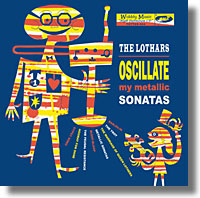Oscillate My Metallic Sonatas
A flick of the wrist, a wave of the hand and--voil�--music!

Review by Jeff Berkwits
![]() or fans of 1950s science fiction films, the weird noises of the theremin--a peculiar musical instrument played by waving one's hands through electromagnetic fields--are a familiar sound. The primitive device's eerie whoops, whines, whistles and wails enhanced the soundtracks of such classic SF movies as Rocketship X-M, It Came from Outer Space and The Day the Earth Stood Still. Over the years, a few rock groups (The Beach Boys, Led Zeppelin) have also toyed with the unusual noisemaker, but none have embraced it like The Lothars have.
or fans of 1950s science fiction films, the weird noises of the theremin--a peculiar musical instrument played by waving one's hands through electromagnetic fields--are a familiar sound. The primitive device's eerie whoops, whines, whistles and wails enhanced the soundtracks of such classic SF movies as Rocketship X-M, It Came from Outer Space and The Day the Earth Stood Still. Over the years, a few rock groups (The Beach Boys, Led Zeppelin) have also toyed with the unusual noisemaker, but none have embraced it like The Lothars have.
 This daring quintet combines four theremins, a guitar and a violin on their latest release, Oscillate My Metallic Sonatas. A scratchy sound--reminiscent of an old 78-rpm LP--dominates the first melody, a tune titled "Gypsy Song," before fading out just prior to "Metallic Sonata No. 1," a lengthy improvised number that showcases a skulking riff and haunting, repetitive tones. Similarly atmospheric themes are explored on "Banjolin," "Metallic Sonata No. 2," "Metallic Sonata No. 3" and "Hooray For Dane." "The Trot" introduces energetic tremolos that swoop and soar over an indistinct guitar background, and the aptly named "Bleep-Bloop" accentuates percolating plops and plinks.
This daring quintet combines four theremins, a guitar and a violin on their latest release, Oscillate My Metallic Sonatas. A scratchy sound--reminiscent of an old 78-rpm LP--dominates the first melody, a tune titled "Gypsy Song," before fading out just prior to "Metallic Sonata No. 1," a lengthy improvised number that showcases a skulking riff and haunting, repetitive tones. Similarly atmospheric themes are explored on "Banjolin," "Metallic Sonata No. 2," "Metallic Sonata No. 3" and "Hooray For Dane." "The Trot" introduces energetic tremolos that swoop and soar over an indistinct guitar background, and the aptly named "Bleep-Bloop" accentuates percolating plops and plinks.
Soft, resonant notes launch "The Marriage of Queen Lothera," an ethereal selection spotlighting ghostly moans and eerie hums, while "Gypsy Song (Reprise)" restates, with a few added flourishes, the CD's initial track. The 11-cut collection closes with "The Feudal Resistance," a 19-minute tune offering a hypnotic environment that mixes slightly shrill sounds with a wavering, multilayered electronic clamor.
Archetypal audio effects
Modern, high-tech synthesizers are able to create a near-infinite array of sounds. Yet, other than adding solid-state circuitry, the theremin has changed little since its initial development in the 1920s. This leaves the instrument with a comparatively limited musical palette. Fortunately, this shortcoming hasn't stopped The Lothars from presenting an enticing--albeit occasionally disconcerting--assortment of uncanny compositions.
"Metallic Sonata No. 3" is perhaps the most otherworldly number, employing gentle artificial chimes and whines to evoke a comfortable, but somewhat surreal, floating-in-outer-space feeling. "Metallic Sonata No. 2" is profoundly meditative, incorporating trembling strings that slowly intensify as deep moans and whistles undulate through the work. With its bassy, bubbly sounds, "Bleep-Bloop" presents a more active scenario, juxtaposing an easygoing beat with slithery electronic tones. Meanwhile, the band exhibits a subtle sense of humor on "The Feudal Resistance," not only through the Star Trek-inspired title but also by inventively assimilating industrial-music dissonance with archetypal artificial effects.
The CD's cover art is another crafty allusion. It mimics an illustration used on a well-known Benny Goodman disc, and serves as a sly reminder that many of the group's creations are, at least to some degree, improvisational in nature. That extemporaneous approach mars such songs as the leaden "Hooray For Dane" and the unduly repetitious "Banjolin," both of which would benefit from a more structured presentation. Nevertheless, even with these faults, Oscillate My Metallic Sonatas remains an adventurous and rewarding listening experience.
Folks interested in learning more about the theremin might also want to check out Theremin: An Electronic Odyssey, a superb documentary that tells the incredible tale of Leon Theremin, the man who invented the instrument. -- Jeff
